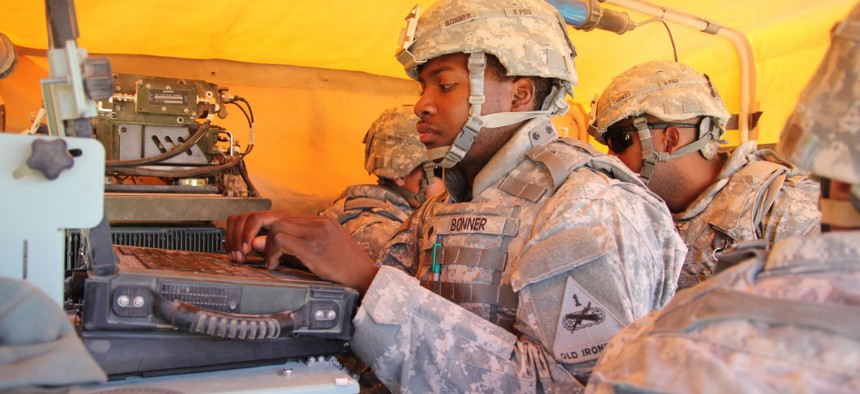
Army adding top-secret layer to expeditionary command posts
The DCGS-A Intelligence Processing Center will add another secure network to forward-deployed communications.
While the Army is making its forward-deployed command posts small, lighter and more mobile, it also is working to make them more secure, adding another top secret layer to its Distributed Common Ground System-Army.
DCGS-A and the Army’s Communications-Electronics Research, Development and Engineering Center, or CERDEC have developed the prototype DCGS-A Intelligence Processing Center, or IPC-2, which will add a second top secret network for intelligence processing, fusion and reporting, CERDEC said in a release.
In part with the idea of supporting relatively small expeditionary forces that could be deployed for specific, short-term missions, the Army has been working to develop leaner command post systems, including ultralight command post tents that can be set up quickly and host a communications hub, deployable “expeditionary sustainment commands” and several vehicle-based command posts that can be set up on the go.
IPC-2 could add a necessary level of security to those operations.
“The IPC-2 is the backbone of the Intelligence processing capabilities,” said Lee Wyman, DCGS-A Operations Specialist and project lead for IPC-2. “It is located inside a hard shelter, attached to a high-mobility, multipurpose wheeled vehicle and backed up to the BCT [brigade combat team] command post to function as the main processing center.”
The wheels on the system’s frame keeps with the mobility theme and makes it easier to set up in a command post, but its most important feature is its secure networking. IPC-2 currently connects with the Secret Internet Protocol Router Network, or SIPRNet, and the Joint Worldwide Intelligence Communications System and will add the National Security Agency Network, known as NSANet. “By providing the NSANet to IPC-2, we are reducing the time and space required to set up separate top secret servers in the command post tents,” Wyman said.
In working on the IPC-2, CERDEC engineers had to address a number of factors involved in getting the technology into a small space, which included how to get power to the unit while providing ample cooling. Among the steps was adding an Improved Environmental Control Unit, or IECU, that senses cooling needs an automatically responds accordingly.
“Now the soldier will no longer have to guess if enough cooling or heating is being supplied to the equipment, which will help him or her focus on the task at hand instead of environmental conditions,” said Mark Miltenberger, C4ISR Prototype Integration Facility project lead for IPC-2.
Next up for the new IPC-2 prototype is some further testing in September, as it move toward deployment to expeditionary commands.
NEXT STORY: Air Force to improve Military Code GPS receivers

